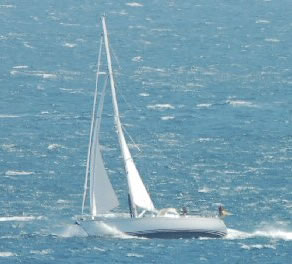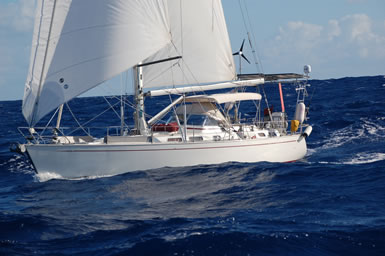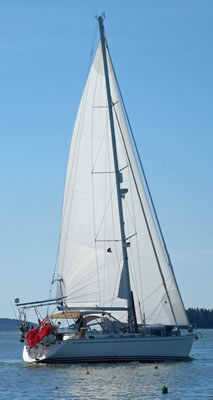Cutter Rig
 |
Staysail and reefed main in 35+ knots of wind |
As many cruising sailors opt for the cutter rig, Iain Simpson has asked me to add an addendum based on my experience with our Najad 460, Serafina of Maldon.
For a short handed crew as with my wife Sarah and myself, in sailing down from Scandinavia and around the Mediterranean before crossing the Atlantic for the Caribbean and onwards up the east coast of America and back to the West Indies, we have found that the cutter rig with its high clewed jib supplemented with a fixed inner foresail both on furlex gear, provides the ultimate in ease of sail handling.
On the wind in fair weather, the jib together with the staysail provides great pulling power with the knowledge that when the wind pressure increases either the staysail or the foresail can be furled from the cockpit leaving the other sail to continue alone. As a rule of thumb, we can sail as a cutter between 60 degrees and 120 degrees off the wind. When close hauled we tend to use either the foresail or the staysail depending on wind strength. Interestingly the hard wind sail (cutter staysail) allows us to head a good 5 degrees higher.
 |
Simbo Rig deployed in mid-Atlantic |
As wind strength increases further,we drop down to just the hardwind jib (cutter staysail) which can then be gradually furled until it becomes a bomb proof storm jib. This together with an appropriately reefed in-mast furling mainsail can accommodate our needs right through to severe gale force without leaving the safety of the cockpit.
On bearing off onto a run, the hard wind jib is furled away leaving the twin jibs to be set very much after the style already outlined under the Simbo Rig page. The only difference of significance, is that when furling the sails from a run because the staysail foil is in the way, we allow the twin jibs to blow forward of the forestay to then furl them in backwards. When going from a run onto a reach it is possible for the weather jib to fly to leeward around the staysail foil. For this manoeuvre the high cut clewed jibs make it a bit easier but for ease and protection of the sails we usually furl the twins, bear away and then reset them.
The same is true when tacking up wind as the slot for the jib between the outer and inner headsail stays is tight. Of course, this would not be a problem with a traditional cutter rig with twin yankee jibs and staysail although the twin yankee jib sheets would need to lead back to higher set whisker poles.
Although we originally had a genoa on acquiring Serafina of Maldon new from Najad, we have since dispensed with that sail in favour of our cutter rig with the added advantage of the Simbo Rig.
 |
|
Flying the VMG 'Flossie' without a mainsail beating up a narrow channel packed with lobster pot buoys in Maine, USA. |
VMG Headsail: However, on sailing the east coast of America we discovered that the winds are generally very much lighter which is why so many American yachts have huge headsails. So for our second season there we had a lightweight 165% headsail on a continuous self-furling line made. This is much along the lines of a Code Zero but it was specifically designed for upwind sailing and it has proved a resounding success. We use it in light airs and it is good for winds up to 15 knots across the deck before it has to be furled. However it can remain in place furled (it runs from the spinnaker halyard down to a shackle on the stemhead) as it is clear in front of the foresail, allowing us to sail using any of the other sail combinations with ease. Without any issues this sail is good for sailing between 40 degrees and 160 degrees off the wind (the latter with the mailsail furled away).